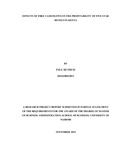| dc.description.abstract | For a company to survive in highly competitive environment of today, it must at least
temporarily achieve a competitive advantage. Penrose (1959) pioneered resource-based
view (RBV) and emphasized those resources internal to the firm as the principal driver of
firm profitability and strategic advantage. Penrose argued that it is the heterogeneity, not
the homogeneity, of the productive services available from its resources that give each
firm its unique character. Competitive advantage is attained when a company moves into
a position where it has an edge in coping with competitive forces and in attracting
customers (Porter, 1980). KPC offers such services as transportation, storage, loading,
receiving from stakeholders, transporting and dispensing petroleum products. A major
challenge faced by Kenya pipeline corporation value chain is bullwhip effect and reverse
bullwhip effect. This challenge is not only unique in KPC. When competition is fierce,
companies must precisely manage their activities and costs to sustain their competitive
advantage. However a critical review of existing literature reveals very scanty empirical
studies on value chain analysis and competitive advantage. The few available ones are of
foreign origin and therefore their findings are not compatible to the Kenyan situation. It is
against this backdrop that the study sought to carry out a research to answer the question;
to what extent does Kenya Pipeline Company limited use value chain to achieve
competitive advantage? This research was conducted through a case study. Primary data
was collected using an interview guide which was administered to Managers from the
following departments; engineering, operations, administration, procurement, human
resource, projects, business development and corporate planning at Kenya Pipeline
Company as the respondents. The qualitative data collected was analyzed using content
analysis technique. From the findings, KPC competitive basis are based on the fact that
the company has heavy investment in infrastructure and that the company enjoys
government support as the investment arm of government. From the findings, the
government is involved in licensing players in the industry, ensuring quality product
through the supply chain, controlling market prices through ERC, Industry benchmarking
through its various arms with the overall mandate being the Ministry of Energy Kenya.
The study established that indeed KPC uses information system in both the value chain’s
inbound and outbound logistics through Modules in SAP that are currently being rolled
out. KPC uses the Balanced score card as its performance management system in all the
four dimensions in KPC terminologies. The study found out that the company operates at
90 % of the target time in a 24 hours operation. The study also concludes that, the
logistics manager in KPC helps in Planning for the product orders based on available
hulage (space) and projected demand in the market. Another notable role of logistics
manager in KPC is to ensure products are available to the oil marketers at the designated
depots. The study recommends that value chain analysis presents organizations with an
overarching tool for improving their strategic planning and resource allocation. The study
also recommends that analyzing costs and differentiation through the value chain is an
essential component in the search for competitive advantage. | en_US |

